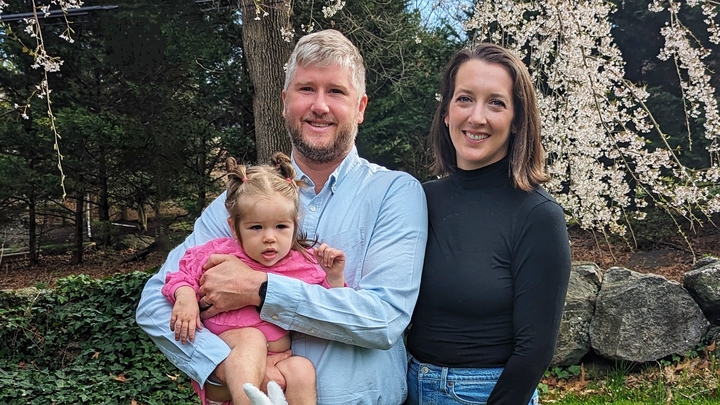Caring for a Rare Variation of a Rare Disease
Caring for a Rare Variation of a Rare Disease
When Amelia’s newborn screening came back indicating she had an abnormal fatty acid profile, her parents, Mark and Paige, were told to feed her every two hours, but that was about it. The abnormal screening signaled something wasn’t quite right, as they later found out.
It wasn’t until she came to Children’s Hospital of Philadelphia (CHOP) with low blood glucose (hypoglycemia) at 6 weeks old and the family was connected to the Congenital Hyperinsulinism Center that they learned Amelia had an extremely rare form of hyperinsulinism (HI) called S-CHAD HI.
“We spent baby’s first Christmas in CHOP,” Paige says. “As scary as it was to learn your baby has a rare type of a rare genetic condition, CHOP did everything possible to help us celebrate the holiday — we picked out presents from the Snowflake Station — while the HI team was creating a treatment plan for Amelia.”

Frontline medication works — with a dietary twist
HI is already rare, with one in 25,000 to 50,000 newborns having the condition. But the S-CHAD variety of HI is so rare that there are only about 50 cases ever reported in the medical literature. It is caused by mutations in the HADH gene.
In hyperinsulinism, the beta cells in the pancreas secrete too much insulin, which in turn lowers blood glucose to dangerously low levels.
Diazoxide, the front-line medication for HI, is effective at raising glucose levels to a safe range in those with S-CHAD HI. But for better management of blood glucose, patients also need to be careful with their diets because they are extra sensitive to protein. Consuming protein alone will lower the child’s glucose to dangerously low levels. That means the child needs to frontload carbohydrates in a meal, before moving on to eating protein.
Breastmilk has enough carbs that mealtimes have only gotten tricky as Amelia, now 20 months old, moved on to eating solid foods.
“Breakfast starts with fruit and cereal before we offer an egg,” Mark says. “She’ll have a big bowl of noodles and a little chicken for dinner.”
As she has grown, both her diazoxide dose and carb-to-protein ratio have needed adjusting. “It’s as if we’re trying to hit a moving target,” Paige says.
Keeping her safe

Paige and Mark test Amelia’s glucose several times a day, especially after a nap — “Which is like a three-hour fast and seems to trigger a low,” Mark says — and after meals to make sure her levels aren’t low. They keep tubes of cake icing handy, if she needs a quick jolt of sugar, and glucagon is on hand, too, for an emergency.
“Sometimes on the tray of her stroller we’ll have fruit snacks, marshmallows and juice,” Paige says. “Other parents give us some odd looks.”
The HI Center is only a phone call away, if they have questions. Amelia will have yearly protein tolerance tests at CHOP to guide her treatment.
“We think it will be easier to manage her sugar when she’s older and can communicate how she’s feeling,” Mark says.
Hypoglycemia is key symptom
Amelia’s genetic mutation that caused the S-CHAD HI also affects an enzyme that is involved in processing fat in the body. But, the predominant symptom of the disorder is low glucose levels, according to pediatric endocrinology fellow Herodes Guzman, MD, MPH, who has treated her at CHOP.
Both Paige and Mark carried the recessive HADH gene, but didn’t have any symptoms. There is a 25% chance with each pregnancy that a resulting child would inherit S-CHAD hyperinsulinism.
As Amelia grows, there’s a chance her hypoglycemia will be less severe and she’ll be able to manage the condition with diet alone, making it unnecessary for her to take diazoxide.
The family feels fortunate to live in Wilmington, DE, just a short drive from CHOP. “It’s amazing that CHOP has a whole center for HI,” Mark says. “It’s the best place in the world with the best doctors in the world for this.
“We feel lucky that her HI can be managed with medicine and diet. To us, she’s perfect.”